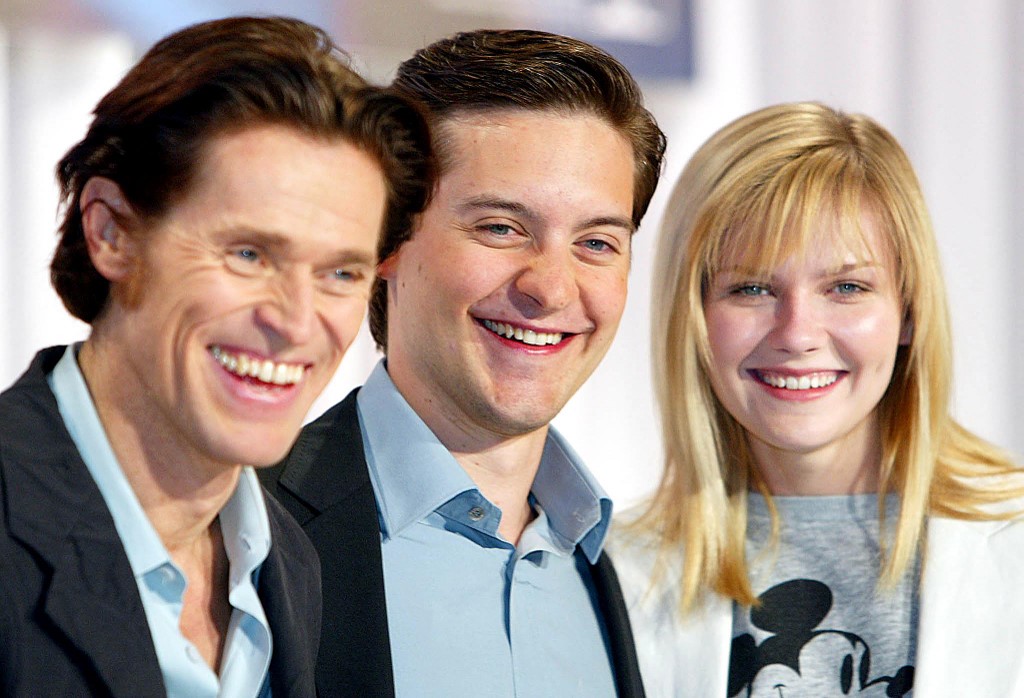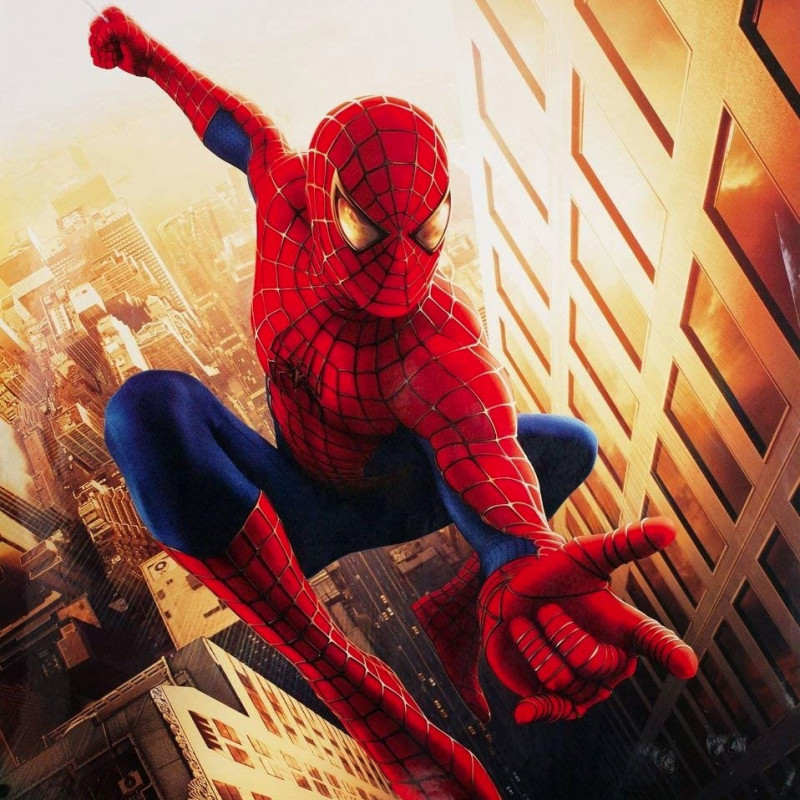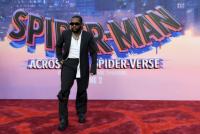IT was a packed house at the Loews Orpheum on 86th Street and 3rd Avenue, Manhattan, on a summer’s day way back in 2002 – my first summer in New York City. It was free seating so there was plenty of jostling to get good seats. I was alone so it was easy. Movie cinemas at their best are a communal experience, and we were all here for the same thing: we wanted to see Spider-Man.
It had been less than a year since the terror attacks on 9/11, and things were slowly getting back to normal – not that I knew, I’d only been there since November – but it still felt like people needed permission to have fun. People wanted escapist entertainment, and that’s what summer movie season is about.
(Ironically, the very first teaser trailer for the movie prominently featured the twin towers.)
Directed by Sam Raimi, with a script by veteran screenwriter David Koepp, based on the iconic comic books by Stan Lee (Excelsior!) and Steve Ditko, the story of a poor kid from Queens who no one believed in, but was given immense powers (and responsibility), who went out and did the right thing, despite the odds, struck a chord with audiences.
Unsurprisingly, the movie was a massive hit, making US$115 million on its opening weekend, eventually making US$825 million worldwide – making it the biggest superhero movie of all time up to that point.
Past to present
Superhero movies had obviously been around for a while, with the Christopher Reeves' Superman premiering in 1978, with sequels (of diminishing quality) released throughout the 80s. In 1989, Tim Burton’s take on Batman starring Michael Keaton was the biggest movie of the year. Three sequels followed… of diminishing quality.
While those iconic characters from DC Comics made waves, rival publisher Marvel was struggling to make it onto the silver screen. The House of M was in trouble in the 90s, filing for bankruptcy in 1996.
One of the ways it dug itself out of this hole was by selling off the film rights to its most iconic characters. Sony Pictures made off with Spider-Man, while Fox picked up the X-Men. The now-iconic characters of the Marvel Cinematic Universe, Iron Man, Thor, and Captain America garnered little to no interest.
Spider-Man, since his first appearance on the pages of comic books in 1962, has always been a beloved character. While many superheroes were godly figures or enormously wealthy or ridiculously exceptional in whatever way, Queens-born Peter Parker was always very relatable to comic book readers. This was a guy who struggled to pay the rent and whose personal life was always a mess.
From the 60s to today, the high profile writers have swung aboard to put their stamp on the character. For 90s kids, there was the popular animated series that lasted five seasons and had 65 episodes. I remember that, unlike most cartoons, the show had extended story arcs that stretched throughout a season.
This enduring popularity, relatability and relevance of Spider-Man meant that a big-budget film adaptation was all but inevitable.
Dawn of the modern superhero movie

In 1998, Marvel had a hit movie with Blade, starring Wesley Snipes as a half-vampire ‘daywalker’ who eliminates supernatural threats with equal parts swagger brutality. Aimed at an older audience, to the point that most people did not know about the character’s comic book origins, Blade was a cult favourite.
In 2000, Fox came out with X-Men, written and directed by Bryan Singer, and starring a cast featuring acting legends Patrick Stewart and Ian McKellan, as well as newcomer Hugh Jackman. It was reasonably successful but didn’t really set the world on fire. It was also drab and seemingly uncomfortable with the more cartoonish aspects of superheroes.
This was the legacy of Batman & Robin (1998), a spectacular failure that veered too far into the colourful and landed the Caped Crusader in movie jail until he was restored by the sober Christopher Nolan in 2006’s Batman Begins.
When it came to bringing Spidey to life, Sony handed the reigns to Sam Raimi, who started his career off with a bang in the 80s with a string of low budget yet hugely successful cult horror/action comedies in the Evil Dead franchise. These movies granted him the nerd credibility that he still has with him to this day, despite his foray into more dramatic (though still genre) movies in the 90s. If anything, his career was in a bit of a lull when he got to work on Spider-Man.
By all accounts, Raimi was incredibly passionate about the character of Peter Parker, as someone who nerdy kids could look up to, and whose failures were just as important as his high-flying heroism. In many ways, he was the right man at the right time.
Making Spider-Man
While many superhero or comic book movies up to that point were set in fantastical worlds or really heightened versions of reality, Spider-Man took place in a very believable version of New York City. It’s a real place with real people, which allows for the super-heroics to stand out even more.
This grounded feel extended to the tone of the movie. At no point does a character wink to the camera about the absurdity of the situation or are there jokes poking fun at the story. What it has is a strong sense of sincerity, which is an extension of how Peter Parker carries himself.

Of course, the tone isn’t exactly grounded, oftentimes rising to melodrama, especially in scenes between Peter and Mary Jane Watson, one of the most enduring relationships in the history of comics. Coming out of 1999’s Oscar favourite, Cider House Rules, Tobey Maguire was not the first choice, with movie stars like Leonardo DiCaprio, Heath Ledger and Jude Law targeted by the studios. Raimi insisted on Maguire because he better embodied what he saw in the character.
The now-iconic performance of Norman Osborn/Green Goblin by Willem Dafoe is not naturalistic at all, instead opting for something larger than life. The incredibly accomplished actor, who is equally able in both over-the-top movies and sober-minded adult dramas, could not have known that he would inspire a treasure trove of memes (many of which can be found on r/Raimimemes, but that is just an undeniable legacy of the movie.

Rounding out the cast were Kirsten Dunst as Mary Jane, Cliff Robertson as Uncle Ben, Rosemary Harris as Aunt May, James Franco as Harry Osborn and JK Simmons as J. Jonah Jameson. In limited screen time, Robertson imbues Uncle Ben with the necessary gravitas needed to inspire Peter, while Harris is the heart of the movie.
By now the MCU has fine-tuned comic book origin stories to a science, to the point where if you’ve seen one, you’ve seen them all, barring some tweaks here and there, but in the early 2000s, the tropes had not yet been set in stone. Spider-Man made a departure by delaying the reveal of the character in the full costume to 45 minutes in. By spending all that time building up Peter (and beating him down a bit), it was even more cathartic when he started actually webslinging.
The movie ends at an interesting point. Though the Green Goblin is vanquished, Peter had to kill someone he looked up to and who was also his best friend’s father. The anger Harry Osborn would carry toward Spider-Man would sour their relationship. More importantly, Peter gets to be with Mary Jane as she realises how much she cares about him.
Unfortunately, Peter knows that by being Spider-Man he has a higher calling and has to put aside his personal happiness. This kind of tragic ending is perfect for the character and was a departure from the happy endings that crowd-pleasing blockbusters tend to have. This melancholy would be even more elevated in Spider-Man 2.
Spider-Man’s legacy
The massive box office success and the enormously positive fan and public reaction meant that Spider-Man and superhero movies would be here to stay. The subgenre, which was little respected 20 years ago, is now the defining style of movie and television (for good and ill, depending on who you ask).
Spider-Man 2 followed in 2004, and if anything was even more critically acclaimed. Spider-Man 3 was a box office success but was not well received, and marked the last of this iteration of the character, with many of the creatives like Maguire and Raimi moving on. Andrew Garfield picked up the reins with his two Amazing Spider-Man movies, which received a mixed at best response.
After a (very) brief pause, the character returned with Tom Holland as Peter Parker in three exceedingly well-received movies – not including supporting roles in three MCU instalments. It culminated in last year’s No Way Home, which made US$1.9 billion on its own, and had Maguire and Garfield return as their versions of the character. With that movie, Spider-Man properties have now made US$8.2 billion making it the most popular comic book character, even topping Batman.
Right now, the fate of the character is up in the air as No Way Home ended in a sort of reset of the franchise. In the real world, the character sharing deal between Sony Pictures and Marvel Studios is also in flux. No one really knows when the next live-action Spider-Man will see the big screen. But given his enduring appeal, he will be back sooner rather than later. – The Vibes, April 30, 2022






















